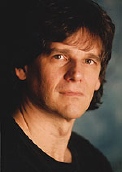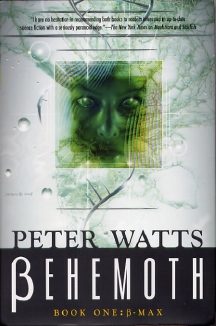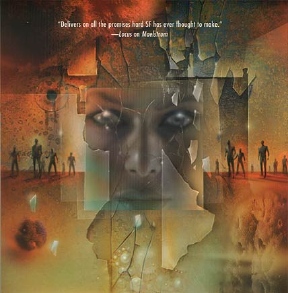An Interview With Writer Peter Watts
The Agony Column for July 6, 2004
Interview Conducted by Rick Kleffel
In 'Maelstrom' they let it rage, just because they're really pissed off and they can. Both are very dark, very detailed and dense looks that will skirt the edge of comprehensibility -- just as a vision of the real future would. Watts' vision is mind-boggling in all the right ways. But it's been over two years since Watts' 'Maelstrom' came out. Since many of my readers may have missed both 'Starfish' and 'Maelstrom' the first time round, they're in the enviable position of being able to easily find and buy hardcover firsts of both for a reasonable price. They're both short, compact novels, though they're dense and not perhaps a super-fast read. Still, you can start in on 'Starfish', and by the time you're reading 'Behemoth: B Max' the sequel, 'Behemoth: Seppuku' will be in the stores. [This assumes that you take your time and don't just plow through them, one after another. Believe me, you may want to to do just that.]
Well, it turns out that for purely fiscal reasons, reasons created by the limitations on what the big chains will buy, Watts had to split the novel that was to be the conclusion of the shall-we-call-it Behemoth Trilogy. In his 'Author's Note', he says: "Behemoth
is being released in two volumes, several months apart.
I wish this were not necessary, but new policies have resulted
from recent changes within the publishing industry.
Henceforth,
books by midlist authors will not receive wide
distribution if they cost too much -- that is, if they weigh
in at more than
about 110,000 words. "Behemoth
is over 150,000 words long, and was almost complete by the time
this policy came into effect.
Hacking away a third of
it was not an option (believe me, I tried)...A
two-part release was the only alternative.
RK: I just
got a copy of this novel and I can't tell you how much I'm looking
forward to it.
PW: Who/what is Night Shade? (I would ask the same thing about JK Potter, except I just Googled and found his home page. Oooo. That stuff is *visceral*.) RK: I'm wondering if you can tell me anything more about the second part of the Behemoth -- no spoilers! PW: How serious are you about the no spoilers part? Because I'd be happy to send you a Word file, or an rtf, or a pdf of the second volume if you'd like (since, after all, you guys weren't supposed to have to wait five months to finish the damn thing anyway). And if you want to see the cover art for Seppuku, check out the Real World/Gallery corner of my website. (In fact, check out my website anyway: it's completely revamped since last we spoke, with loads of new content. I think you'll like it.) If you *want* to be deprived, well, fine. Here's a spoiler-free hint: In part one, our heroes (such as they are) get ominous hints of what's happened to the rest of the world in the five years since the events of "Maelstrom". In part two, they go back on shore and immerse themselves in it. And also reacquaint themselves with an old friend. RK: …and why you chose to write about "space vampires". Shades of Colin Wilson and 'LifeForce' a pretty great B movie in the old tradition of Professor Quatermass. Your next novel is also described as literary -- aside from the fact that it's literature, why? PW: I just liked the absurd juxtaposition--a "literary" novel about "space vampires"? Has kind of a Spinal Tap pretentiousness to it. In fact, "Blindsight" is not really *about* space vampires: one of the characters just happens to be a resurrected vampire working in space. Here's my description of the guy, taken from the outline:
(Just to add to the above: It was this very linkage that led to their extinction. It developed in a natural fractal environment without Euclidean geometry, and hence wasn't weeded out before it got fixed in the population via genetic drift. When baseline Homo figured out how to build huts, it was the beginning of the end. With the development of straight-line architecture--specifically, intersecting right angles-- vampires found themselves unable to approach the domiciles of their prey without spazzing out. You can be damn sure the prey figured out how to use *that* to their advantage.) (Cool, huh?) But the book isn't about this guy. The book actually uses the conventions of a first-contact story to explore the nature and evolutionary significance of Human consciousness, and ultimately proposes that Humanity is doomed by its own self-awareness. (I'm talking sentience here, *not* intelligence--two totally different things, although most people tend to confuse them.) And once again, I can hardly wait to see where Watts goes. He's way too smart to be in writing for the money, so you know he's doing it because 1) he's really, really good at it, and 2) he enjoys writing. This is exactly what you want from those behind your books. That and the devilish sensibility the Watts beings to the table. Here's my advice; get out your Bookfinder.com, buy up the first editions of 'Starfish' and 'Maelstrom', then hustle down to the bookstore to pick up 'Behemoth: B Max'. Wait for the conclusion, start the first one then hang on. With luck, by the time you're ready for another immersion in the caustic world of Peter Watts, he'll have those space vampires running nekkid through the streets of London. Or not. |




